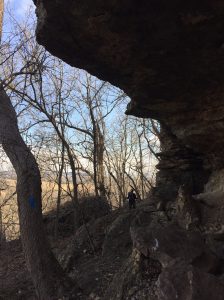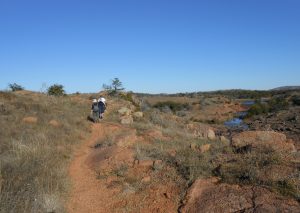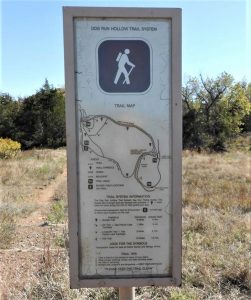Hiking into fall
Fall is a great time to get outside, walk and closely observe nature's changes. Signs of seasonal transition are everywhere. Goldenrods are peaking with dense blossoms harboring a collection of frenzied bees, wasps, beetles, grasshoppers and southbound butterflies. Post-breeding Franklin’s gulls are migrating en masse toward the interior lakes of Kansas while stationary lone orb weavers wait for dusk to rebuild their exquisite deathtraps. Apples and pumpkins appear prominently at fall festivals as we anticipate a landscape shift toward those same rich shades of yellow, orange and red. Acorns, sycamore bark, black walnuts and Osage Orange fruit alter the groundscape further signaling summer's end. Autumn triggers arrivals, departures and endings. It's a period of discovery.
 Trails are an excellent place to enjoy the changing seasons. Kansas Trail Guide: The Best Hiking, Biking and Riding in the Sunflower State is a well-researched and recommended source to help you choose trails to explore this fall and into winter. The authors feature photos of Kansas’s remarkable geography, maps and regional histories. Directions to the trailheads, level of difficulty, trail distance, park fees and unique points of interest enhance this guide.
Trails are an excellent place to enjoy the changing seasons. Kansas Trail Guide: The Best Hiking, Biking and Riding in the Sunflower State is a well-researched and recommended source to help you choose trails to explore this fall and into winter. The authors feature photos of Kansas’s remarkable geography, maps and regional histories. Directions to the trailheads, level of difficulty, trail distance, park fees and unique points of interest enhance this guide.Close to home, a day trip to the North Shore Trails at Clinton State Park in Lawrence won’t disappoint. Conveniently accessed via the park's cabins and campgrounds, these easy to moderate trails wind through a deciduous forest offering scenic shoreline views. The Kansas Trail Guide notes the White Trail and the Blue Trail are top biking trails, but don’t let that deter you as you aren’t likely to meet many bikes unless there is a scheduled event.

Elk River Hiking Trail
Further south near Independence, the Elk River Trail--a trail the authors include in their top 10--features a rocky landscape with blufftop views of the Elk River and Elk City Lake reminiscent of the ridgeline trails along the Buffalo River in northern Arkansas. It’s a superb, well-marked trail great for winter hiking as leaf-off allows easy views of the water.
For a weekend trip, cross the border to southwestern Oklahoma and the Wichita Mountains Wildlife Refuge where hiking within the refuge's boundaries now through late fall is spectacular. Open and wooded landscapes featuring lakes, creeks, cactus, longhorn cattle, bugling elk and bison are refuge highlights, with more than 30 miles of nature trails to explore. Bring binoculars and a field guide to help you identify the birds you will see. The refuge's website has a bird checklist and printable field guides of other wildlife inhabiting the area. The visitor center has maps and staff to help you determine which trail is a good fit for you.

Wichita Mountains Wildlife Refuge

Wichita Mountains Wildlife Refuge
Before exploring unfamiliar trails, prepare by researching visitor center hours, rules for dogs on the trail and campground closures. Stop to read trailhead signage and wildlife info, and snap a photo of the trail map--it can be easy to confuse the trail with well traveled animal paths along unmarked sections. Know the weather forecast and pack plenty of water. Venomous copperheads and rattlesnakes are active in the fall so keep that in mind when choosing trails.
All of the trails above include rocky areas. Trails can be completely covered by leaves in the fall, which may obscure protruding rocks and exposed roots or cause the trail to be slippery after rainfall, so hiking poles and quality hiking shoes will make your trek more enjoyable. Visit the Travel Neighborhood in the library, our catalog or Overdrive for tools to help you plan your next trip anywhere!
Photos courtesy of K. Sain and D. Sain.













